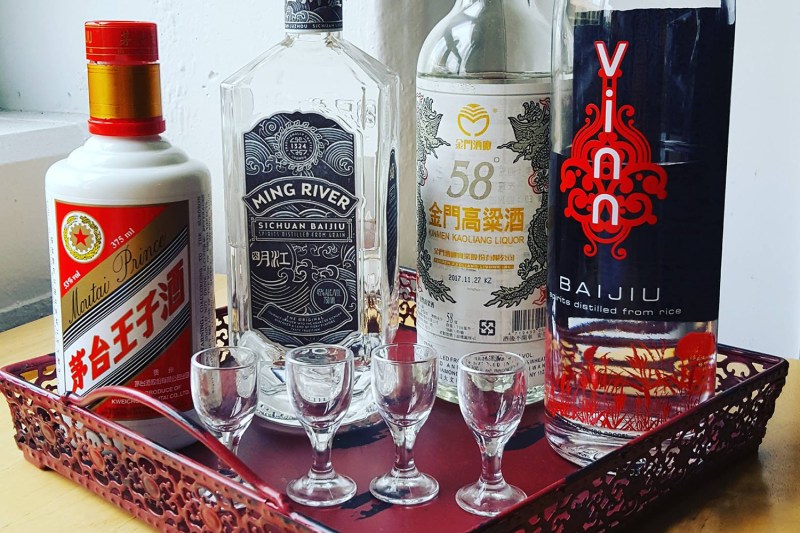Despite its relative obscurity in the United States, the Chinese spirit, baijiu, is one of the most-consumed liquors in the world. Chinese distilleries are starting to invest in marketing the product in markets outside of Asia, including America.
With a reputation mostly as a crazy-strong booze (it’s not unusual for a baijiu to be above 50 percent alcohol by volume), baijiu isn’t so much a specific liquor but what the Chinese call hard liquor, according to Derek Sandhaus, who wrote a book on the spirit while living in China and co-founded the baijiu company, Ming River.
“It’s a very big country and they make a lot of types of hard liquors and call them all baijiu,” Sandhaus said. “The first hurdle with baijiu is to understand past experience is not indicative of what a future experience will be.”

Chinese alcohols pretty much all date as far back as 2,000 BC, using a method mixing grain and water mashed into a paste before incubating and decomposing with mold and yeast. Once the mash is broken done, it’s mixed with fresh grain which helps create the alcohol. The mash is called qu.
“They didn’t know at the time (it was a few thousand years before modern chemistry), but what the mold does is eat the starch and turns it to sugar, which the yeast eats and turn to alcohol,” Sandhaus said, explaining it’s basically a combination of the malting and mashing process in Western cultures. “You essentially create a solid mash of fermented grains and press the alcohol out. With baijiu, they use a still that is basically a giant dim sum, vegetable steamer.”
In China, baijiu is made to match the regional cuisines — which vary greatly in the giant nation — and are most often served neat along with the food. If not consumed with food, it’s infused with fruits and traditional Chinese medicinal ingredients. Sandhaus said in the U.S., they are trying to introduce it by integrating the flavors in cocktails by working with bartenders.
The four main aromas of baijiu — rice, light, heavy, and sauce aromas — make up nearly 99 percent of the baijiu that is produced and consumed in China.
There are 12 types of regional baijius, according to Sandhaus, but there are four main types, each of which is named by its aroma. A unique production process helps dictate the final flavors. Most taste vastly different than Western styles of booze.
“One thing we like to explain is, yeah, it tastes funny,” Sandhaus said. “It has alcohol in it, but they aren’t doing it the same way so it shouldn’t taste the same way. The flavors they’re trying to produce aren’t necessarily the same flavors of gin, rum, or whiskey.”
The four main aromas of baijiu — rice, light, heavy, and sauce aromas — make up nearly 99 percent of the baijiu that is produced and consumed in China, Sandhaus said. Below, we take a look at the four major styles and an example of each.
Rice Aroma
Vinn Distillery

Hailing from the southern coast of China, the rice aroma baijiu is made entirely from rice and is the gentlest in flavors — like a soft vodka. With cuisine from the region being mild and using subtle ingredients in steamed dumplings and seafood, the baijiu is reflective with its delicate aroma and slightly floral on the palate. Vinn Distillery makes the only 100 percent U.S. baijiu, in Oregon, and is produced by a family from Vietnam, hailing from just south of the Chinese baijiu-producing region.
Light Aroma
Kinmen Kaoliang

In Beijing, cold weather necessitates the strongest baijiu, coming in at 58 percent ABV. Despite the strength, light aroma is quite smooth and also quite subtle in flavor. The food in Northern China is often hardy and salty — meat and potato or noodle dishes lacking heavy spices. For this style, look for Kinmen Kaoliang, which is made in Taiwan. Sandhaus likened light aroma, appropriately, to grappa on the nose, and on the palate, the baijiu is grassy and herbaceous. And while all baijius can have a slight barnyard funkiness on the backend, it’s most notable on the light aroma.
Strong Aroma
Ming River Baijiu

Perhaps most friendly to Americans will be strong aroma baijiu. From the southwest of China, the strong aroma smells intensely of pineapple and is full of fruit notes ranging from papaya to apple and follows with a bit of that funkiness. The strong sweet flavors are meant to tame the spicy cuisine in the Sichuan province it hails from. This is the style of Ming River’s baijiu, which is made in a partnership with the oldest continuously-operated baijiu distillery which uses production pits dating back to 1573.
Sauce Aroma
Kweichow Moutai Prince

Without a doubt, the most challenging baijiu for Westerners will be sauce aroma, which is full of umami flavors not normally found in beverages. From a region less than 100 miles from where the Ming River baijiu is produced, the cuisine is similarly spicy, but with sour notes. These savory notes within the baijiu help temper those food flavors and come from a hybrid production method that cooks the mash more than the other aromas. A supremely funky aroma leads to flavors of sesame, soy sauce, and mushroom on the tongue. Check out Kweichow Moutai Prince. Sandhaus equated it to jumping into really peaty Scotch without knowing other whisky well, but that sauce aroma is very popular in China.


